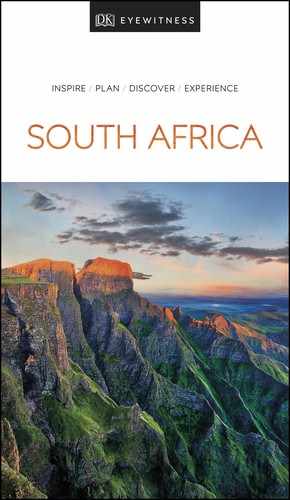Experience More

t The red exterior of Museum Africa, part of the Market Theatre Complex
Originally an Indian fruit market, the Market Theatre Complex is the centre of the Newtown Cultural Precinct. A great effort has been made to make this a safe place to visit, and the complex now houses entertainment venues, restaurants and shops.
Opposite the Market Theatre, the Africana Museum (1935) was relaunched in 1994 as Museum Africa. The theme is Johannesburg and its people at various stages of sociopolitical transformation.
West of the theatre is the Oriental Plaza bazaar, where, some 360 shops and stalls sell everything from carpets to clothing. Many traders are descendants of the Indians who came here in the 19th century
=
Museum Africa
⌂ 121 Lilian Ngoyi St, Newtown § 11 833 5624 # 9am–5pm Tue–Sun
=
Oriental Plaza
⌂ 38 Lilian Ngoyi St, Fordsburg # 9am–5pm Mon–Fri, 9am–3pm Sat ∑ orientalplaza.co.za
CITY SAFETY
Soaring crime rates in central Johannesburg during the 1990s prompted a business and hotel exodus to more suburban locations. Regular visitors will tell you that much of the crime has since shuffled off to suburbia too, but still it would be reckless for a first-time visitor to explore the city centre independently; opt for a guided tour instead.
South African Breweries (SAB), established in 1895, is the largest brewer by volume in the world. This modern museum offers an entertaining display of the company’s long history. Other exhibits focus on the development of brewing in ancient Mesopotamia and illustrate how beer-brewing came to Africa and Europe, with excellent reconstructions of a “gold rush” pub and a traditional Soweto shebeen.
This characterful street was first established in the mid-1880s by Indian and Chinese settlers who set up businesses to serve the original mining town. Today, the row of Victorian and Edwardian shops still sell fabrics, hardware and kitchen utensils.
At the end of the street is a delightful statue of anti-apartheid activists Walter and Albertina Sisulu. The figures sit opposite each other holding hands, and the inscription reads: “Walter and Albertina Sisulu married in 1944. Through their enduring love and dedication they became parents to the nation.”
At No 14, Kwa-Zulu Muti is a working herbalist shop, a traditional side of Africa still very much a part of daily life for many South Africans. Not all the potions and remedies are herbal; its fascinating stock includes animal skins, horns and claws, as well as dried bats, frogs and insects. Visitors can seek advice from a sangoma, a traditional African healer.
Kwa-Zulu Muti
⌂ 14 Diagonal St § 011 836 4470 # 8am–5pm Mon–Fri, 8am–1pm Sat
Part of the University of the Witwatersrand, this centre traces the origins of man from the Stone Age, and houses the country’s most important Khoi and San rock art.

t One Being by Deborah Glencross, on display at Johannesburg's Origins Centre
The unusual setting of a working bank conceals a sophisticated gallery that provides a showcase for talented local and international artists. The building also hosts regular concerts.
EXPERIENCE Johannesburg and Gauteng
|
STAY Agterplaas B&B This homely spot is a short walk from the boutiques and eateries of the trendy Melville neighbourhood. ⌂ 66 Sixth Ave, Johannesburg ∑ agterplaas.co.za African Pride Melrose Arch Hotel An ultra-modern design hotel with a first-rate fusion restaurant. ⌂ 1 Melrose Sq, Johannesburg ∑ marriott.com Garden Place Guest Houses Set in lovely gardens, this guesthouse is close to the hip suburb of Norwood, and offers an in-house shuttle service. ⌂ 53 Garden Rd, Johannesburg ∑ gardenplace.co.za Michaelangelo Towers A prestigious all-suite hotel that overlooks Nelson Mandela Square. ⌂ Maude St, Sandton ∑ legacyhotels.co.za Saxon Hotels, Villas & Spa Unabashed luxury with contemporary African decor and a world-class spa. ⌂ 36 Saxon Rd, Johannesburg ∑ saxon.co.za |
The former Government Square, dating from 1893, was completely refurbished as a large piazza-style public space in 2002. It was also given a new name, after Mahatma Gandhi, who came to Johannesburg in 1903 and worked as a lawyer and civil rights activist. Gandhi’s profession often brought him to the Transvaal Law Courts (now demolished), which were located in the square.
In 2003, a larger-than-life-sized statue of Gandhi in his lawyer’s robes by sculptor Trinka Christopher was unveiled here. Trendy shops, restaurants and cafés line the southern side of the square.
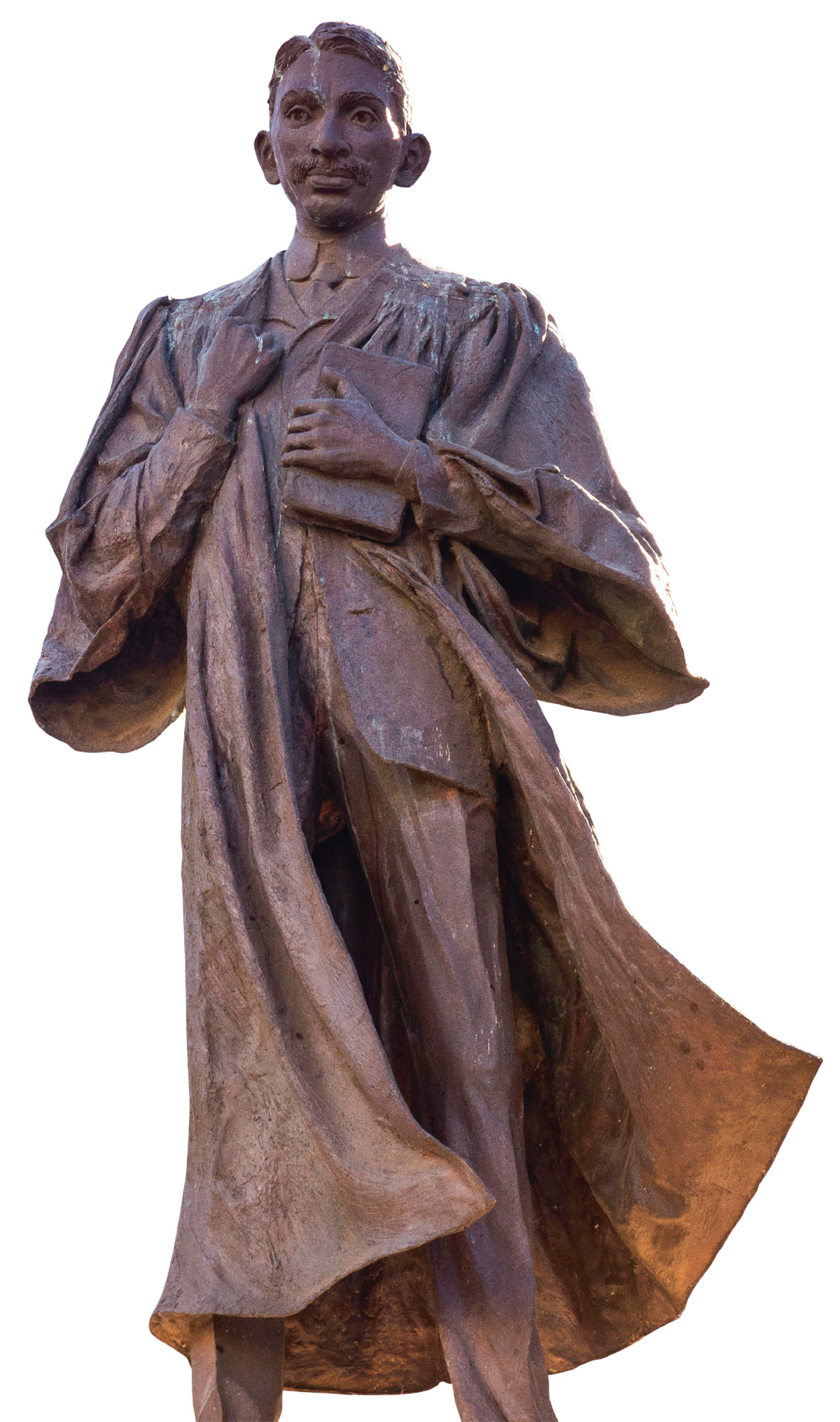
t A statue of a young Gandhi, standing in Gandhi Square
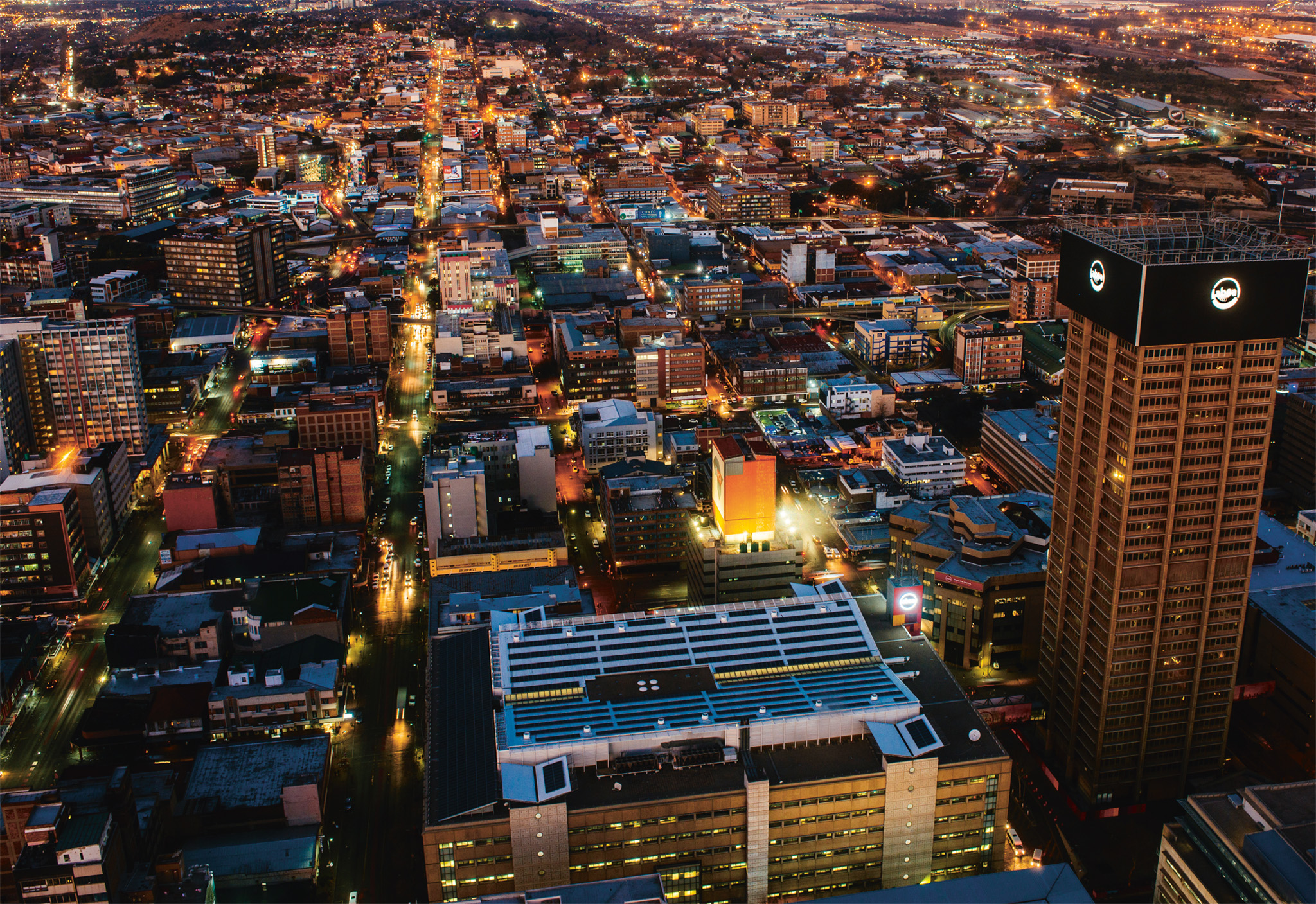
t Johannesburg, as seen from the Top of Africa in the Carlton Centre
A key downtown landmark, the Carlton Centre is 223 m (730 ft) tall, making it Africa’s highest building. For a small fee visitors can take the lift up to the Top of Africa observation deck on the 50th floor, where panoramic views of the city can be enjoyed. On very clear days, the Voortrekker Monument near Pretoria can be seen. The building was completed in 1973 as part of a hotel complex (no longer in operation) and today there is a mall on the lower levels.
Situated in Joubert Park, this gallery has over 9,000 works in its collection. Those on display include examples of traditional, historical and modern South African art, as well as several works from European schools, including 17th-century Dutch and Flemish paintings and a collection of Pre-Raphaelite artwork. There are also interesting collections of ceramics, furniture and textiles on view.
DID YOU KNOW?
Johannesburg is planted with 10 million trees, making it one of the world’s largest man-made forests.
Opened in 1947 to honour South Africa’s role in the two World Wars, this outstanding museum also covers the Anglo-Zulu War, the Anglo-Boer War and the South African resistance movements. It displays more than 44,000 items, including the nation’s official war art and war photography collections. It is also home to some of the world’s rarest military aircraft.
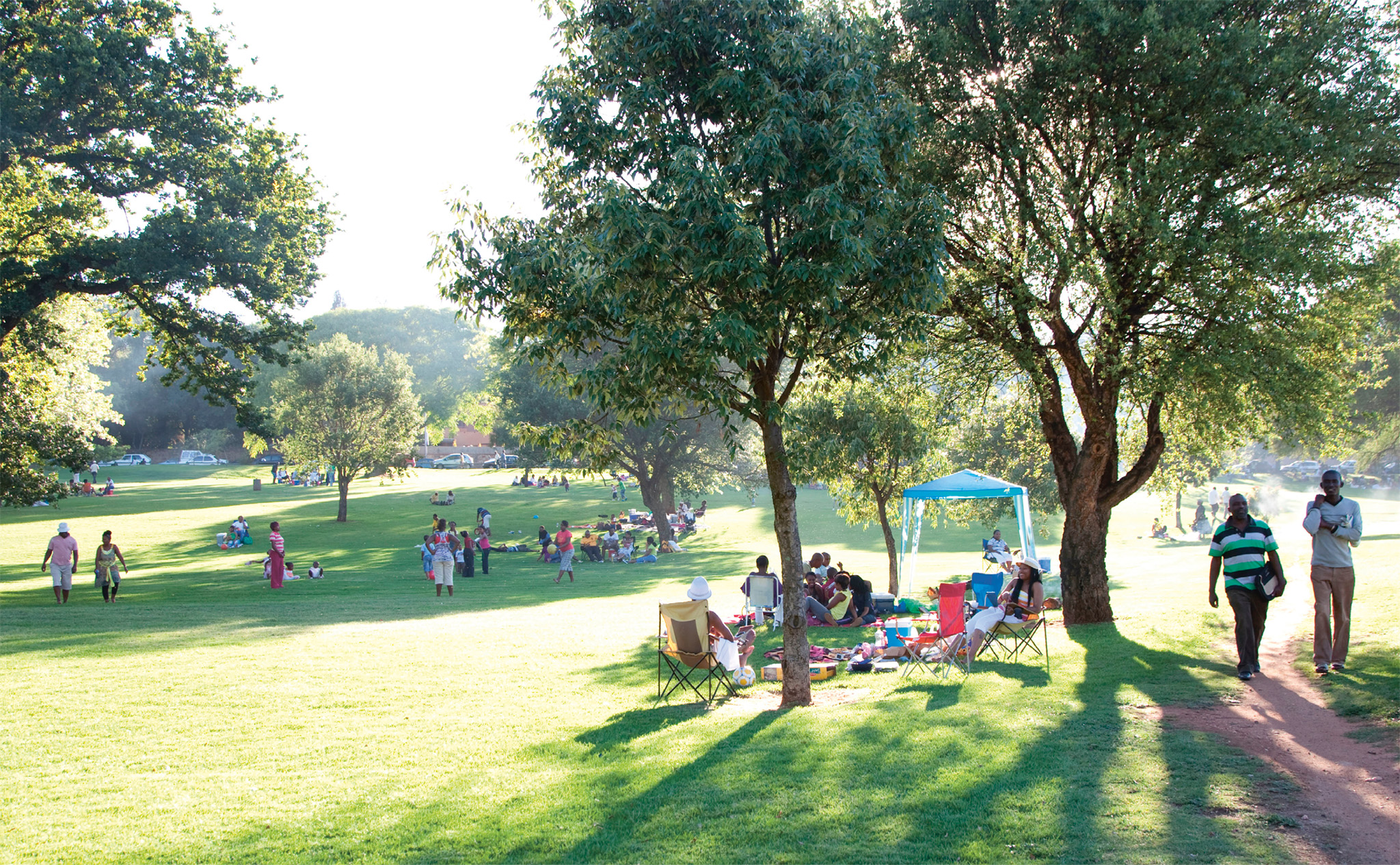
t The well-kept lawns of Zoo Lake, which lies across the road from Johannesburg Zoo
This well-regarded zoo’s spacious enclosures are home to some 2,000 animals across 350 species, including Africa’s only polar bears. The zoo occasionally opens in the evenings for night-time tours to see the nocturnal animals. Across Jan Smuts Avenue, Zoo Lake is a large park with an open-air swimming pool.
In the heart of the central business district, this traffic-free section of Main Street is lined with office blocks that are home to many corporate and mining companies. Dubbed the Mining District Walk, an outdoor museum includes relics from the gold-rush days as well as modern sculptures and water features. On weekdays Main Street is filled with office workers enjoying the street cafés, and with a high security presence it is a safe area to explore.
This remarkable development is a living museum documenting South Africa’s turbulent past and its transition to democracy. The site incorporates the Old Fort Prison Complex, a notorious jail for more than a century where many, including Nelson Mandela, were imprisoned. South Africa’s Constitutional Court, initiated in 1994 after the country’s first democratic elections, occupies the eastern wing.
EXPERIENCE Johannesburg and Gauteng
|
Eat Moyo This multi-level restaurant offers a range of dining experiences, all centred around a delicious menu of Afro-fusion dishes. ⌂ Melrose Arch, Johannesburg ∑ moyo.co.za Browns of Beverley Hills This city institution serves a continental menu in a serene location in Lonehill. ⌂ 31 Mulbarton Rd, Johannesburg ¢ Mon The Butcher Shop & Grill This family-run – and family-friendly –restaurant is a one-stop-shop for excellent steak. It also has an adjoining butcher and deli. ⌂ Nelson Mandela Sq, Sandton ∑ thebutchershop.co.za Est Est Alea Located in the suburb of Parktown North, this fine-dining establishment is the brainchild of chef Dario De Angeli. Head here for a sublime tasting menu, with optional wine pairings. ⌂ 4th Ave, Johannesburg ¢ Sun & Mon ∑ estestalea.co.za |
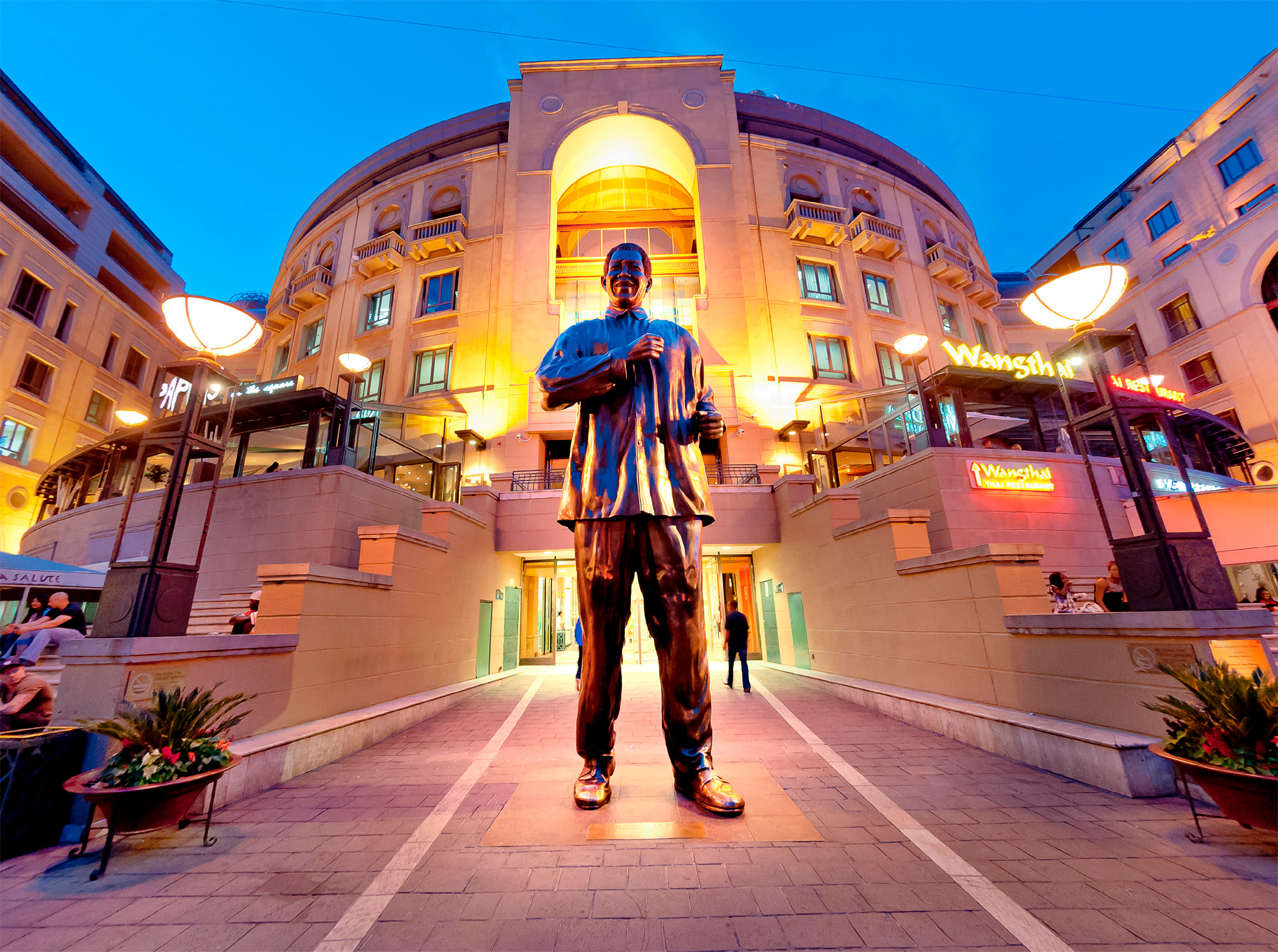
t Statue of Nelson Mandela in his eponymous square, next to Sandton City
North of Johannesburg, the metropolitan sprawl blends into expensively laid-out residential areas with high walls, spacious gardens, swimming pools and tennis courts.
Affluent Sandton is a paradise for fashionable shoppers, with Sandton City reputedly the most sophisticated retail centre in the southern hemisphere. It is especially noted for its speciality shops, trendy boutiques, jewellers and dealers in African art, curios and leatherwork. The centre also has plenty of entertainment on offer, with cinemas and dozens of excellent bistros and restaurants. A number of five-star hotels adjoin the Sandton City complex and Nelson Mandela Square, where an Italianate fountain is the focal point in a little piazza lined with coffee shops and restaurants.
The residential suburb of Rivonia, north of Sandton, is home to Liliesleaf Farm, once a rural farmhouse and now an award-winning museum dedicated to the apartheid era. It was on this farm that, on 11 July 1963, the South African security forces carried out a raid that ended with the arrest of most of the leaders of the African National Congress. The ANC representatives, including Walter Sisulu and Govan Mbeki, were imprisoned after the Rivonia Trials later that year. Although Nelson Mandela had been arrested six months earlier, he was also part of the Rivonia Trials, which marked the beginning of his 27-year incarceration. Liliesleaf opened to the public in June 2008, and since then thousands of local and international visitors have flocked to this important heritage site. South of Sandton is Rose-bank, where the Rosebank Mall offers a buzzing mix of chain stores, upmarket boutiques, restaurants and entertainment, including a ten-pin bowling alley and a number of cinemas.
- =
Sandton City
⌂ Cnr Sandton Dr & Rivonia Rd # 9am–8pm Mon–Sat, 9am–6pm Sun & public hols ∑ sandtoncity.com
" '
Liliesleaf Farm
⌂ 7 George Ave, Rivonia # 8:30am–5pm Mon–Fri, 9am–4pm Sat & Sun ¢ 18 Dec–2 Jan ∑ liliesleaf.co.za
- =
Rosebank Mall
⌂ Bath Ave, Rosebank # 9am–6pm Mon–Thu, 9am–7pm Fri, 9am–5pm Sat & Sun ∑ rosebankmall.co.za
EXPERIENCE Johannesburg and Gauteng
THE SPIRIT OF SOPHIATOWN
Sophiatown – located 10 km (6 miles) from Johannesburg’s city centre – was a crowded shanty town, yet it was also the cradle of urban black culture. Known as the “Harlem” or “Chicago” of South Africa, the township was legendary for its vibrant music scene – particularly jazz – and a bohemian atmosphere that defied the apartheid ideal.
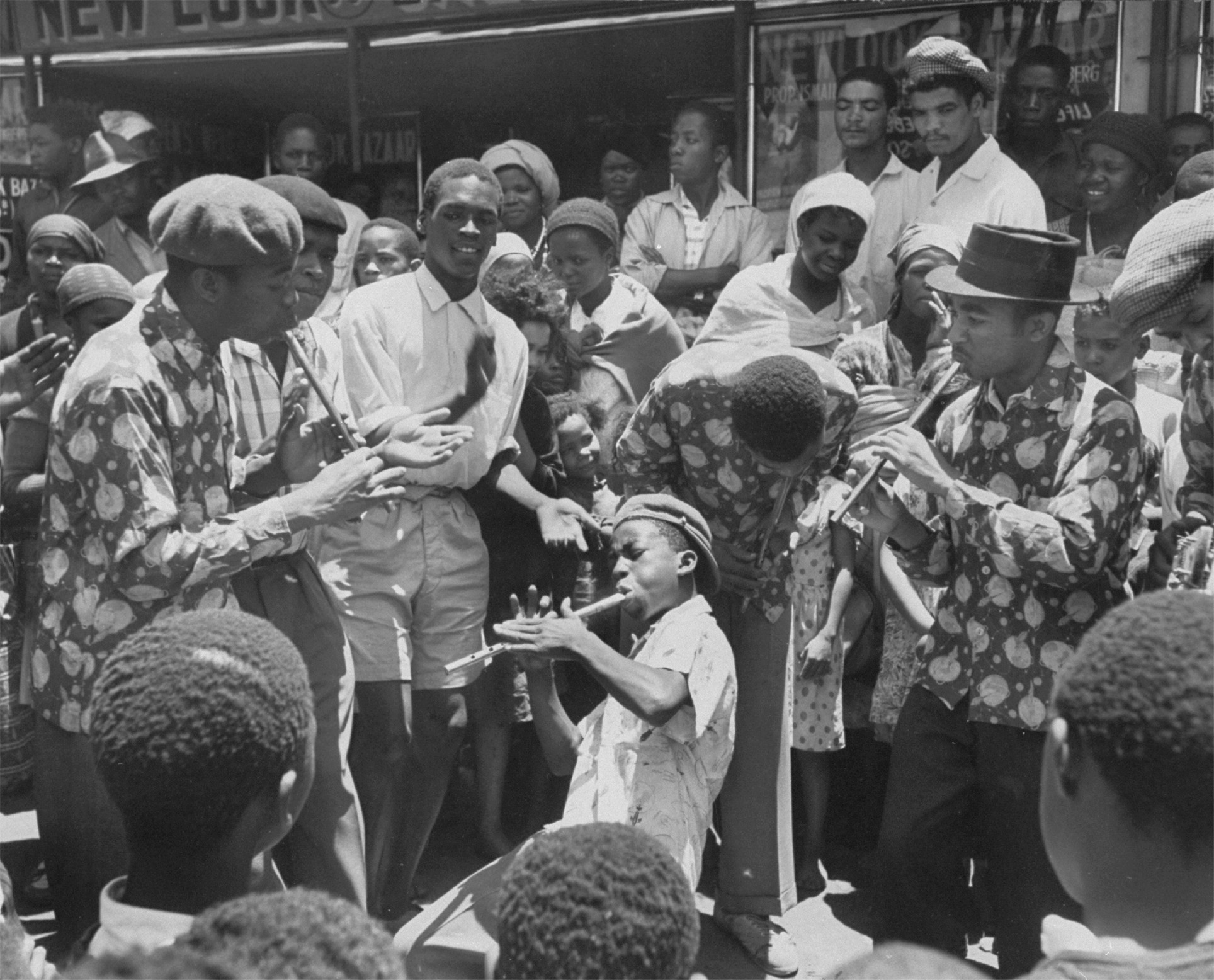
t A troupe of musicians giving an impromptu street performance
A number of townships were established around Johannesburg in the mid 20th century, but Sophiatown’s vibe stood out from the others. Despite it being an area of poverty and crime, much of the creative black African talent of Johannesburg lived in Sophiatown, including artists, journalists from Drum (the first “black” magazine in South Africa) and numerous musicians. The streets and energetic dance halls were filled with the sounds of the penny whistle, saxophone, harmonica, piano, trumpet and clarinet, while at shebeens (illegal bars), such as the notorious Casbah Gang Den, workers and teachers, both black and white, would meet to socialize and debate politics.
In the 1950s, the government ordered the forcible removal of the community to the characterless Meadowlands (now Soweto) settlement. It took four years to remove all of the 60,000 inhabitants, and by 1959 Sophiatown had been demolished and replaced with the white suburb of Triomf. The old name Sophiatown was reinstated for the suburb in 1997.
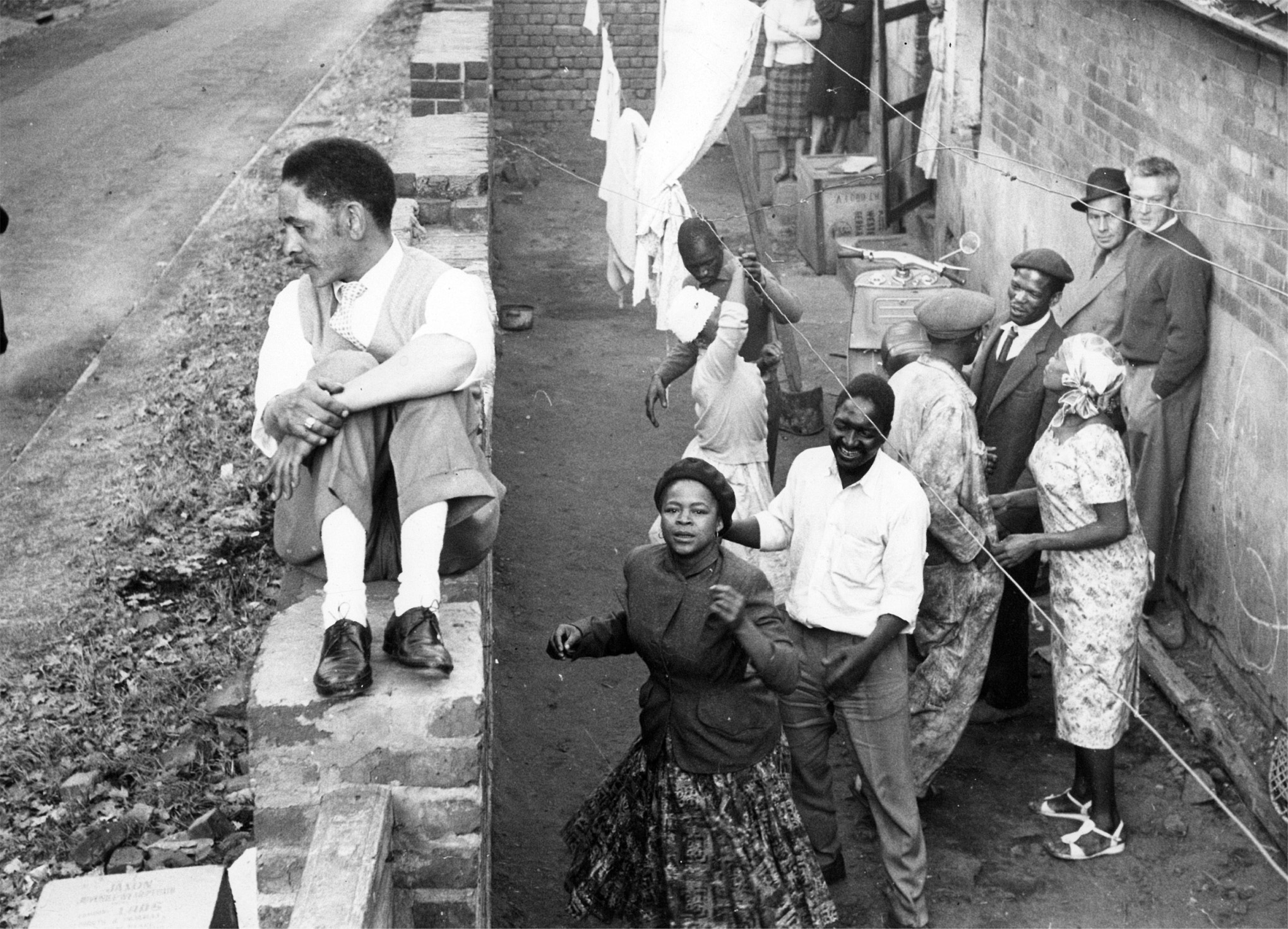
t Locals at one of Sophiatown’s lively shebeens (illegal drinking spots)
DID YOU KNOW?
Sophiatown is named after the wife of Herman Tobiansky, who established the suburb in 1900.
Relocated to a new site near the Cradle of Humankind in 2016, the Lion and Safari Park is a family-friendly facility that offers a tamer but enjoyable alternative to a full safari experience. It houses around 80 lions (including a few specimens of the rare white lion) as well as cheetah, brown and spotted hyena, leopard (including the all-black variant) and African wild dogs. Lions and other large predators live in different enclosures that can be visited on a self-drive basis or as part of a guided tour, but giraffes, warthogs and various antelope have free rein of the 600-ha (1,480-acre) property.
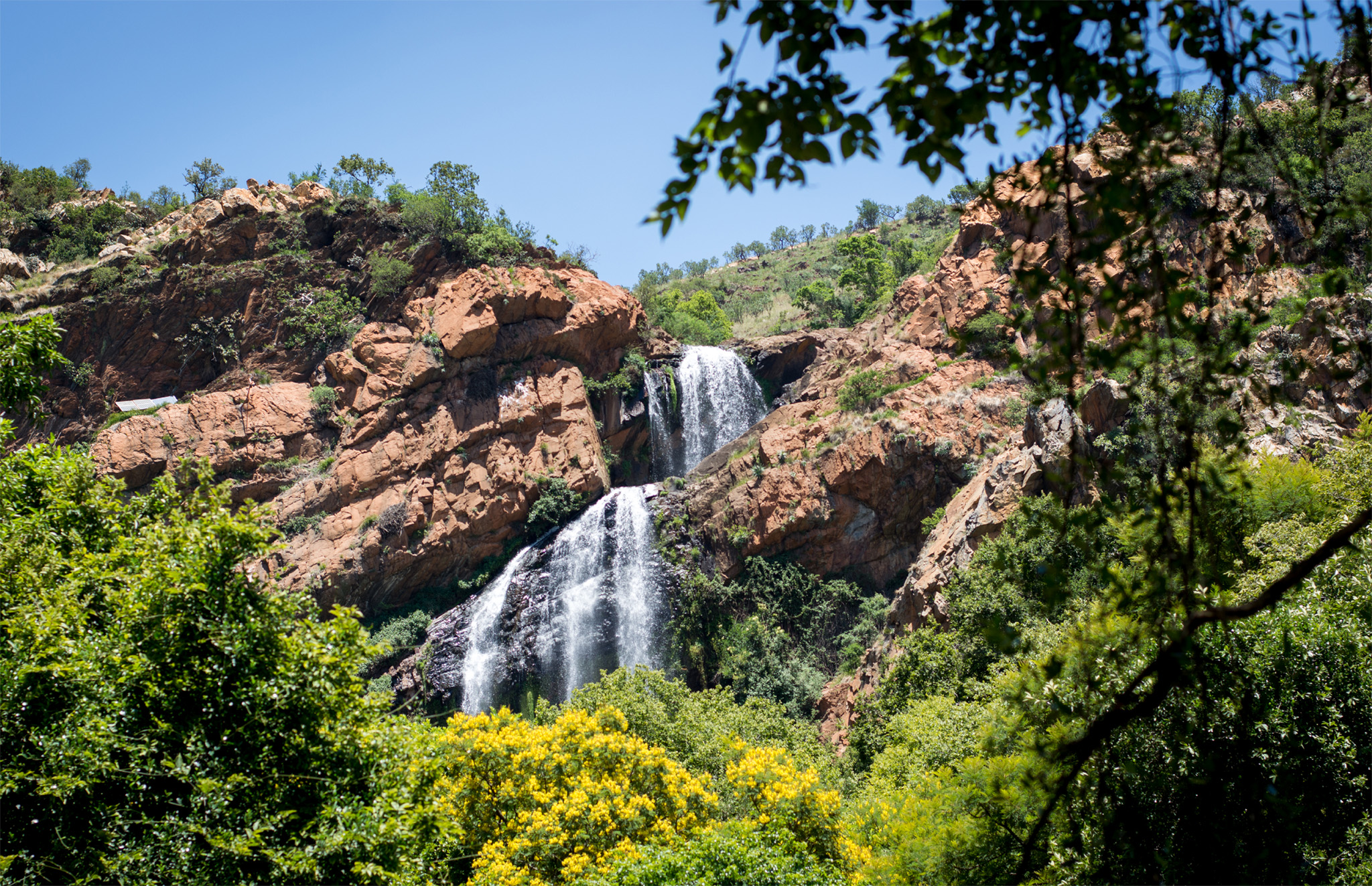
t The Witpoortjie Falls, tumbling through Walter Sisulu Botanical Garden
Opened in 1983 and now entrenched as Gauteng’s favourite back-to-nature venue, this 300-ha (740-acre) botanical garden is home to 600 varieties of indigenous plant, including aloes and proteas; more than 220 bird species, within which is a breeding pair of the spectacular Verreaux’s eagle; and a variety of small to medium sized mammals.
Scenically, the garden is dominated by the Witpoortjie Falls and a small, forest-lined dam overlooked by a bird hide. There is a well-marked network of walking trails, and a variety of themed guided tours is available.
Established in 1971 on what was then a chicken farm, the former De Wildt Cheetah and Wildlife Centre is a captive breeding programme where more than 800 cheetah cubs have been born. It was also the first place to breed a king cheetah – a blotchy-coated variant that was once thought to be a rare subspecies but is now known to be caused by a genetic mutation. Now renamed in tribute to its founder Ann Van Dyck, the centre also runs breeding programmes for other rare species, including African wild dog, brown hyena and the critically endangered riverine rabbit (one of the world’s rarest mammals, with a wild population estimated at 500 adults). Other resident animals include honey badger, caracal and a playful family of meerkats. Guided tours run daily, but must be booked in advance.
Did You Know?
The colouration of the king cheetah, white lion and black leopard are all attributable to recessive genes.
The Magaliesberg is a chain of low hills that runs from west Pretoria towards Rustenburg, and forms a natural boundary between the hot lowveld of the north and the relatively temperate highveld around Johannesburg. The name derives from Mogale’s Berg – Mogale being the name of an important local chief who lived there in the 19th century (and berg simply meaning mountain). The mountains are serviced by many hotels and campsites, which mainly cater to domestic tourism rather than to foreigners. The area is also very popular with Gauteng’s hiking fraternity.
For those with limited time or energy, the Harties Cableway, which climbs from close to Hartebeespoort Dam to the mountaintop, is an excellent short excursion offering stunning views in all directions. Costlier but even more thrilling are the morning ballooning excursions that are also available in the area.
"
Harties Cableway
⌂ Plot 3, Melodie # 9am–4:30pm daily ∑ hartiescableway.co.za
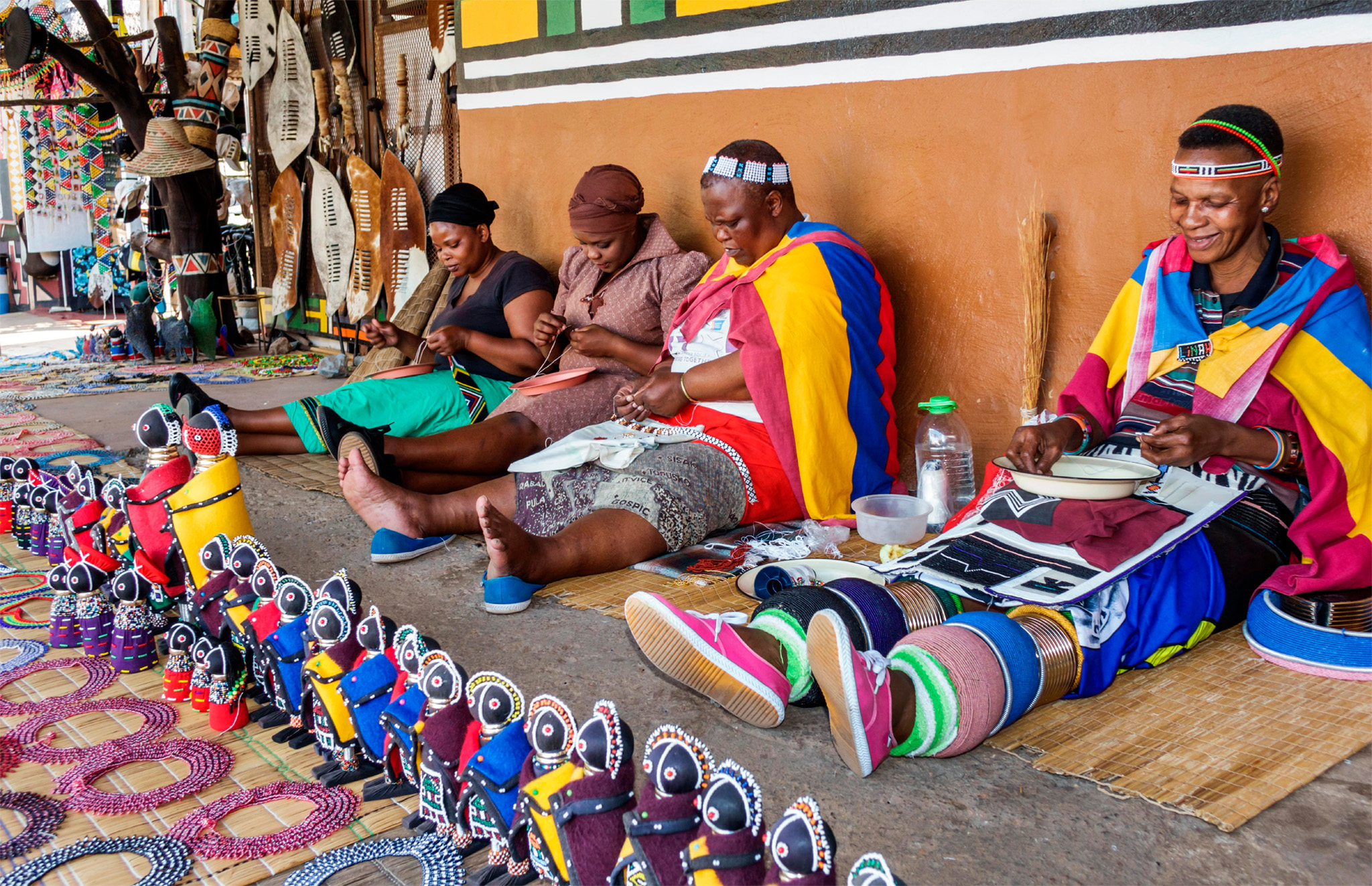
t Women making beadwork items in Lesedi Cultural Village
Gauteng’s equivalent of Shakaland and now under the same management, Lesedi is a large open-air museum where a quintet of replica African villages represents five different South African ethnic groups: the Zulu, Xhosa, Pedi, Basotho and Ndebele. Though inevitably a little contrived, a three-hour tour of the villages is both fun and informative, offering first-time visitors some insight into traditional rural life in Africa. The tour culminates in a lively performance of singing, drumming and dancing. Taking the African theme one step further, the restaurant serves a pan-continental buffet that includes various game meats, and comprises three separate rooms: one dedicated to East Africa (Maasai-themed), another to South Africa (where murals represent the country’s nine main indigenous ethnic groups) and the third North Africa (where you will sit on floor cushions at low tables).
Scenically located at the base of the Magaliesberg range, this 150-m- (492-ft-) long, 60-m- (197-ft-) high dam was built in the 1920s for irrigation. The associated 17-sq-km (7-sq-mile) reservoir has become a prime weekend destination for watersports enthusiasts. For families in particular, this site makes for an enjoyable day out, hosting as it does the Hartbeespoort Dam Snake & Animal Park, the base for the Harties Cableway and plenty of casual eateries.
"
Hartbeespoort Dam Snake & Animal Park
⌂ Scott St # 8am–sunset daily ∑ hartbeespoortsnakeanimalparkco.za
EXPERIENCE Johannesburg and Gauteng
|
EAT & STAY Les Delices de France This cosy restaurant serves authentic French cuisine with a modern twist, and ingredients sourced by the owners. ⌂ 2 Keith Ave, Roodepoort ¢ Mon ∑ lesdelicesdefrance.co.za Silver Orange Bistro A contemporary South African fusion restaurant, located on a working citrus farm. Over-18s only. ⌂ Altyd Mooi Farm, Hartbeespoort ¢ Mon ∑ silverorangebistro.co.za Lesedi Cultural Village Head here to stay in good-value thatched rondawels with bright ethnic decor. ⌂ R512, Lanseria ∑ aha.co.za/lesedi |

t Melrose House, a 19th-century home with much of its interior
As the administrative capital of South Africa and one of the country’s foremost academic centres, Pretoria is home to numerous monuments and grandiose official buildings, some of which date back to the 1800s. This stateliness is softened, however, by the city’s many parks and gardens, whose jacaranda trees add splashes of lilac to the streets each spring.
In 2005 the name of the larger municipality centred on Pretoria was changed to Tshwane, the Setswana name of the Apies River. However, the city itself has retained the name Pretoria (which comes from the somewhat divisive figure of a 19th-century Boer leader, Andries Pretorius).
Historic buildings, gracious parks, theatres and restaurants can be found throughout this elegant, compact city, which centres on the attractive, pedestrianized Church Square. Among the buildings on the square are the Raadsaal (1890), one-time parliament of the former Boer Republic, and the Palace of Justice (1899), used as a military hospital until 1902 by the British. Anton van Wouw’s statue of Paul Kruger was cast in Italy in 1899, the year the Transvaal Republic went to war against the British Empire.
Providing a stark contrast to the square is the angular concrete of the nearby South African State Theatre. This Japanese-style complex has five theatres where ballets, dramas, operas, musicals and classical concerts are performed regularly. Other notable buildings in the centre include the imposing Neo-Classical City Hall, built in 1931. In front of it stand two statues depicting Marthinus Pretorius, founder of the city, and his father, Andries. A statue of the mythical chief Tshwane is nearby. Melrose House, meanwhile, was designed in the 1880s by British architect William Vale for transport contractor George Heys. The house, which features nearly all forms of precast embellishment available, was inspired by Cape Dutch architecture, English country houses and Indian pavilions. During the South African War, Melrose House was the residence of Lord Kitchener, British commander-in-chief, and it was here that the Treaty of Vereeniging was signed on 31 May 1902, ending the war. Today, it hosts a museum, which still contains many of the house’s original contents
Nearby stands the National Museum of Natural History, which contains a remarkable collection of stuffed animals, as well as archaeological and geological exhibitions. Natural attractions are also the draw at the National Zoological Gardens, better known as Pretoria Zoo. One of the top ten zoos in the world, it is very conservation conscious, and much time and effort is spent on breeding programmes of rare or endangered species such as the Arabian oryx.
East of the zoo are the Union Buildings. Designed by the renowned architect Sir Herbert Baker, they were built to house the administrative offices of the Union of South Africa in 1910. Baker himself chose the imposing hill site from where the two large office wings overlook landscaped gardens and an impressive amphitheatre. Although it is not open to the public for reasons of security, the impressive Renaissance style building may be admired from the peaceful gardens.
Around the outskirts of the city, the Voortrekker Monument and museum is visible on the approach from the N1. The site commemorates the Afrikaner pioneers who trekked from the Cape in the 1830s to escape British domination. Construction began in 1938, the centenary of the Battle of Blood River, and it became a focus of Afrikaner unity. The structure features a cenotaph in the Hall of Heroes which is lit by a beam of sunlight at noon on 16 December, the date of the Battle of Blood River.
East of Pretoria on the R104 lies Sammy Marks Museum, once the elegant residence of industrial pioneer Sammy Marks (1843–1920), the founder of the South African Breweries. The house has been beautifully furnished in a Victorian style.

t still preserved
Church Square
⌂ Cnr WF Nkomo and Paul Kruger sts
South African State Theatre
⌂ 320 Pretorius St ∑ statetheatre.co.za
City Hall
⌂ Paul Kruger St
" -
Melrose House
⌂ 275 Jeff Masemola St § 012 322 2805 # 10am–5pm Tue–Sun ¢ Public hols
"
National Museum of Natural History
⌂ 432 Paul Kruger St # 8am–4pm daily ¢ Good Fri, 25 Dec ∑ ditsong.org.za
" =
National Zoological Gardens
⌂ Boom and Paul Kruger sts # 8:30am–5:30pm daily ∑ nzg.ac.za
Union Buildings
⌂ Government Ave, Meintjies Kop # Daily (grounds only)
" -
Voortrekker Monument
⌂ Eeufees Rd, Groenkloof # 8am–5pm daily (to 6pm Sep–Apr) ∑ vtm.org.za
" ' -
Sammy Marks Museum
⌂ Old Bronkhorstspruit Rd, Donkerhoek # 9am–5pm Mon–Fri (tours every two hours) ¢ Good Fri, 25 Dec ∑ ditsong.org.za
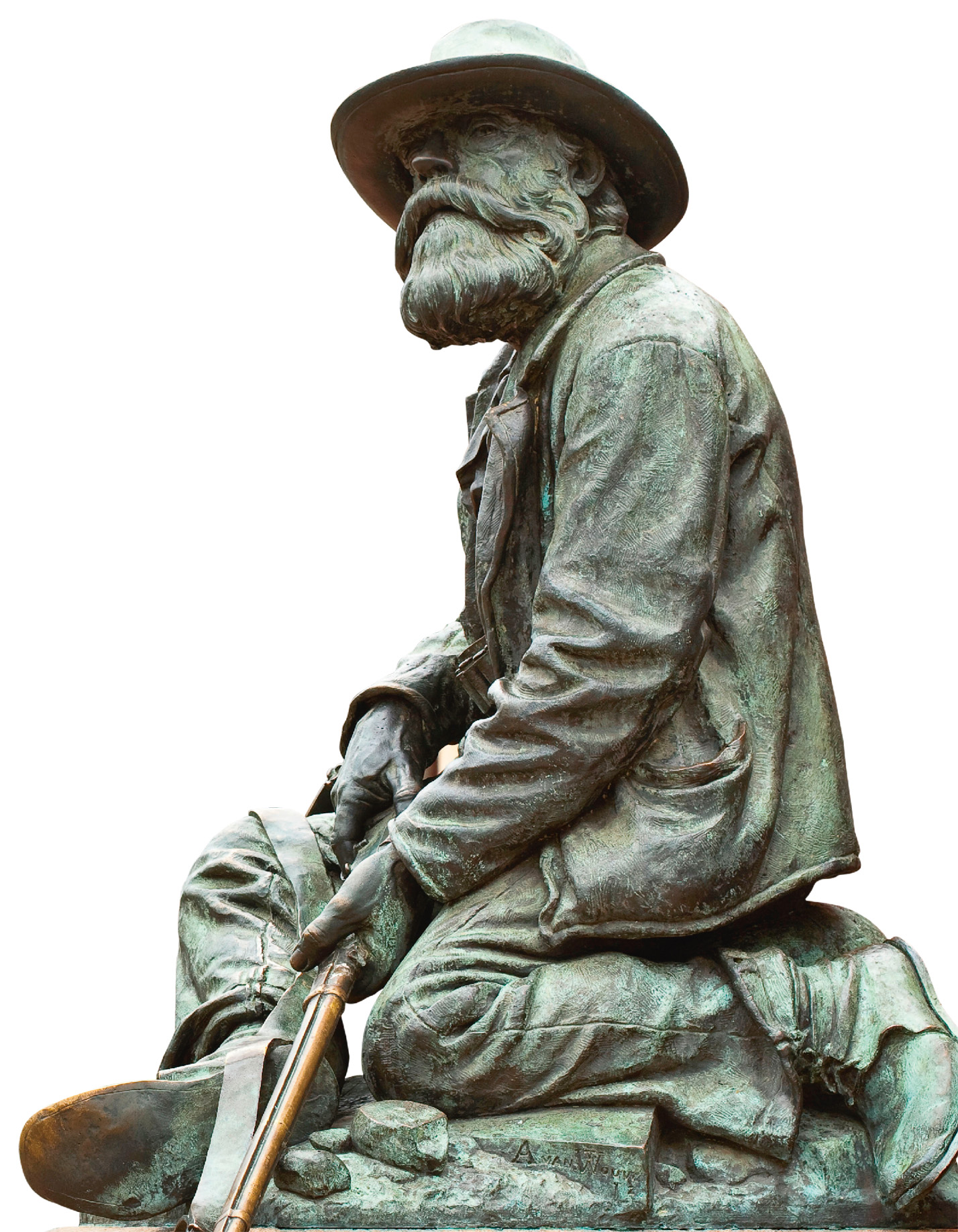
t A segment of the statue by Anton van Wouw that stands in Church Square
EXPERIENCE Johannesburg and Gauteng
NDEBELE ARTS

The hills around Pretoria are the historical home of the Ndebele people, who are noted for their colourful dress and their skill at art and crafts. An outstanding example is the beaded nguba, a “marriage blanket” that the bride-to-be makes under the supervision of the older women in her tribe. Traditionally, the women work the land and are the main artists, while the men fashion metal ornaments that are worn by women.
